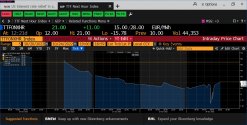- Demand reduction is forcing industry across Europe to idle, and will raise input costs to levels that make European industry uncompetitive. This may persist for several years, causing global supply chains to move away from Europe.
- High energy prices will have long-term implications, in the form of higher debt burden, business failures and changes to the green transition.
Despite efforts to secure sufficient gas supplies for the coming winter, energy market dynamics for Europe in 2023 will be as challenging as in 2022: energy prices will remain elevated, reduced only by demand destruction across the continent, and it is difficult to see where economic growth will come from. Supply constraints mitigate against any significant lowering in price, and the primary strategies for demand destruction will have a negative long-term impact on EU competitiveness.
Supply: the scramble for gas may be worse in 2023
European governments are scrambling to fill their gas stores and are largely on track to reach their target of 95% by November 1st. However, this has largely been accomplished by importing Norwegian gas and liquefied natural gas (LNG) at close to the maximum throughput levels throughout the summer (in previous years there had generally been a summer lull), as well as small supply increases from Algeria and Azerbaijan. Additionally, the reduced supplies of Russian gas arriving between March and August still represented a significant portion of Europe’s imports in 2022. Europe’s maximum non-Russian import capacity has thus increased only slightly, and further new increases in import capacity are coming online haltingly. The installation of up to five floating storage and regasification units (specialised LNG import terminals) in Germany and one in Italy represents the biggest expected increase in supply this winter, but they will not begin to operate before January, and this installation schedule may slip. Additionally, the global LNG market will remain tight until at least 2024, providing little relief on price.
Storage capacity is typically drawn down by roughly 60 percentage points over the course of a normal European winter, with storage units remaining at least 20% full. However, this drawdown has historically occurred alongside continuing Russian gas imports over the course of the winter. Without such imports, even if gas storage were full and demand reduction successful, European gas stores would probably reach near-zero levels by early 2023. Therefore, to meet the 95% storage target in the autumn of 2023, Europe will have to acquire 20% more gas than usual, and unlike in 2022 it will have to do so without any Russian imports, exacerbating supply and price shocks.

